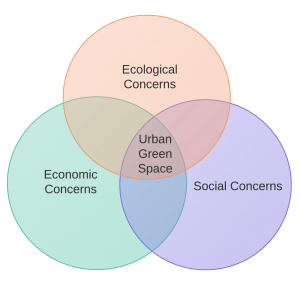Introduction to Urban Green Spaces in China
Rapid urbanization has caused many problems within Chinese cities. As population booms and cities expand, loss of natural greenery leads to elevated levels of air pollution, erosion, and water pollution. Due to urbanization, China was and is forced to reconsider its urban landscapes and address environmental issues to preserve cultural and natural resources.

China and its citizens are still dealing with the repercussions of their rapid modernization through natural land loss, biodiversity loss, and pollution, now common in all parts of the land (Marks, 2012).

In an attempt to backpedal the years of damage and try to reach a better quality of life for citizens and nature, there has been a push for more sustainable measures. This includes the development of urban green spaces in cities, especially in the capital, Beijing.

As a sustainable measure, urban green spaces in Beijing provide ecological, economic and social benefits. As Chinese cities continue to grow, sustainable urban planning will be necessary for more livable cities.
Citation
Marks, R. (2012). China its environment and history. Plymouth, UK: Rowman & Littlefield Publishers, Inc.
Image Citations
Popolon (Author). (2013, August 13). Aerial View. Retrieved from https://commons.wikimedia.org/wiki/File:Beijing_-_Yongshun_zhen_2.PNG
cammell, toby (Photographer). (2007, June 8). China park [digital image]. Retrieved from https://www.flickr.com/ photos/tobyscammell/with/3164636017
Website Header Image Citation
Castelfranco (Photographer). (2009, August 9). Panorama Beijing. Retrieved from https://commons.wikimedia.org/wiki/File:Panorama_Beijing.jpg
